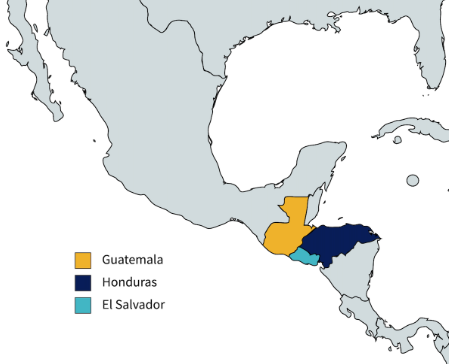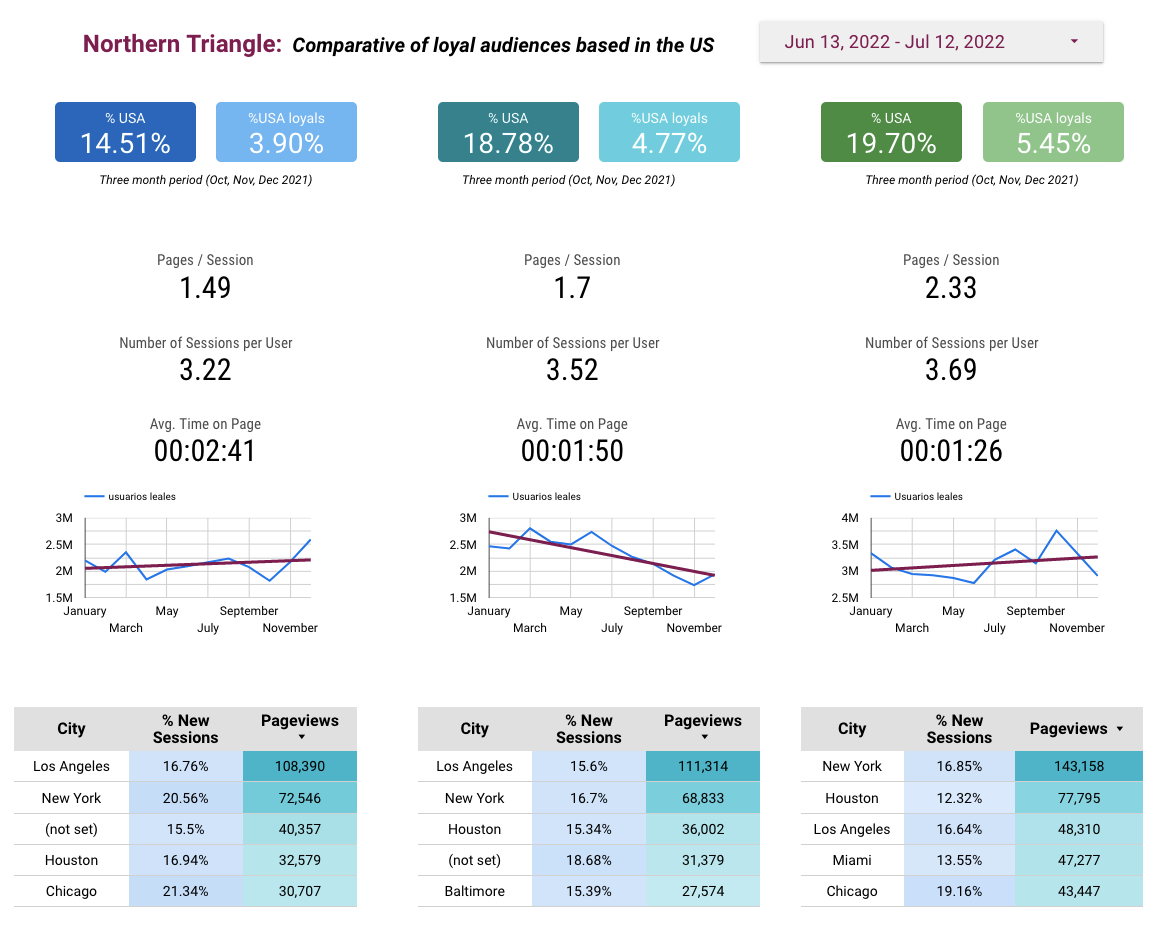In this piece
A five-step plan for leveraging a diaspora audience as an additional revenue stream

Claudia L. Cruz outside the Reuters Institute for the Study of Journalism in Oxford. Photo: Niken Riwu
In this piece
1. Form a task team | 2. Make data-based decisions | 3. Start experimenting | 4. Explore new formats and delivery opportunities | 5. Follow the innovator's guide to changeMedia and business journals have archives full of earnest papers about the decline of legacy media and new revenue models, but the vast majority of that work is based on learnings gleaned from US data and other countries in the Global North.
Media outlets in Central America have faced all the same challenges, but are rarely the focus of study.
That’s why I chose to spend my time as a journalist fellow at the Reuters Institute on audience questions facing the Northern Triangle in Central America, made up of my home country of Guatemala, as well as Honduras and El Salvador.

With this in mind, I asked three of the biggest newspapers in the Northern Triangle to grant me access to their Google Analytics: Prensa Libre (Guatemala), La Prensa Gráfica (El Salvador), and La Prensa (Honduras).
With key insights and advice from Anntao Diaz, Head of News Consumer Insights at Google, I built custom dashboards for each outlet that highlighted audience opportunities.

I then further focused my analysis on what I see as a key monetization opportunity for all three outlets: the diaspora from the Northern Triangle to the US, which accounts for 85% of all migrants from Central America – or over 5 million people.
The full paper in PDF form below presents the aggregated findings of that analysis, builds a profile of the unique needs of that audience segment, sets out a plan for other newsrooms looking to experiment with creating a minimum viable product (MVP) for a diaspora segment, and includes advice from other outlets that have successfully leveraged a diaspora audience segment, including 444.hu in Hungary, NewsLaundry and NewsMinute in India, Fuengirola.fi in Finland, BANTUMEN in Portugal, and the BBC World Service.
If at least 15% of your total traffic regularly originates from immigrants outside the country, you may have a meaningful audience segment worth targeting – and potentially monetizing.
Below is a five-step plan for creating a minimum viable product (MVP) for that audience segment. This is, of course, an oversimplification of a complex undertaking, but use it as a gateway to a task that is inaccurately seen as “impossible”, “expensive” or “complicated”.
1. Form a task team
Appoint a multidisciplinary team, define a specific set of goals, as well as a work methodology. If you have them, ensure the newsroom, sales, finance, information technology (IT), marketing and subscriptions departments all have a strong and equal representation on the team. Have weekly meetings and manage the project by breaking it up into phases using the Agile methodology.
2. Make data-based decisions
As illustrated in the opening sections of my paper, you need accurate and up-to-date information about your diaspora audience with which to build a profile of their news consumption needs.
- Start by investigating what tools will work with the data you have available. Given that many publishers already use Google Analytics, Google Data Studio may be a good initial choice.
- Identify the key performance indicators (KPIs) you need to track in order to meet your goals, and then monitor them regularly. To measure the diaspora opportunity, I tracked: size of the diaspora audience in relation to the total, loyalty segments based on the number of sessions over a 30-day period, country and city-based performance, referring sites, top-read articles by section, front-page and search performance, and projected ad income based on CPMs from the sales team. Keep an eye on loyalty segments by monitoring the ratio of users to pageviews. Users yielding more pageviews will help you define your most loyal diaspora audience. These are the users you have to study, cater to, and where you might find the best chances of monetization.
- As time passes, you will have other indicators to keep an eye on: newsletter signups and open rate, web registries, and others. Be disciplined in keeping track of these figures.
- Consult official third-party sources – such as the International Organisation for Migration (IOM), the World Bank, the Inter-American Development Bank, the United Nations Human Development Reports, the Migration Data Portal, and others that apply – for additional information about your diaspora.
3. Start experimenting
You know you have a relevant diaspora audience, you have a team focused on working with them, now you need to act. You can do this through editorial, tech, subscription or marketing actions. You should consider running different tests in all of these areas, but make sure you do not run them at the same time to avoid confusing results.
From a newsroom perspective, based on the findings of your diaspora audience profile, design a new content strategy. Depending on how much space you have for new projects, you might consider dividing this implementation into two phases. In phase one, focus on curating your existing content in a newsletter, section, app or social media channel targeting this audience. In other words: use what you already have, but mix and display it in the best possible formats for the intended audience. In phase two, once phase one is yielding significant insights, you can move into the production of tailored content.
Ensure these projects are tracked, and once the data shows good engagement, consider implementing a membership and revenue strategy.
While experimenting, supplement your metrics with feedback from the audience. Use any tool available to ask directly what they think about whatever changes or new products you are launching. Keep track of the impact and reactions within the newsroom.
From a technical perspective, you should be monitoring your Web Core Vitals. In many cases, the best efforts to produce relevant high-quality content are undermined by a poorly designed and maintained website.
4. Explore new formats and delivery opportunities
Does your diaspora audience show a pattern of significant commute time, or any other distinctive habit? Consider these aspects when creating new delivery formats. You can experiment with video, graphics, data, visualisations, cartoons. You can deliver content via a podcast, an app, a newsletter.
You can use geo-targeting on social media to highlight special content to the diaspora. You can also check peak times by location in each of your social media accounts. Other aspects that could positively influence the outcome of your social delivery include involving key diaspora influencers or running a paid campaign.
There is no silver bullet for this: each media outlet and audience segment is different, and that is why it is so important to test.
5. Follow the innovator's guide to change
That is: create a minimum viable product, test it with your defined market, gather feedback to MVP performance, adapt the product (or pivot to a new approach), and repeat.
Depending on what you are testing, make sure the period of testing is relevant but not too long. If you fail, you want to do so quickly so that you can learn and adapt with minimal wasted expenditure.
Remember that testing need not be limited to huge transformations. Small but consistent and targeted changes can yield good insights.
Make sure you share results with your newsroom. Celebrate successes and learn from failures with them.
The core question to ask is this: what would this segment consider an added value? Central to answering that question is understanding people’s needs – both material and emotional. And here is where a cold business strategy begins to align with the core mission of journalism itself. Because innovative business practices will build bridges between under-served audiences and the information they need to help them live better lives.
As The State of the Latino News Media report notes, US outlets are struggling to meet these audience needs not just due to a lack of resources, but a “lack of vision and lack of investment in Spanish-language audiences”. To put it another way: legacy news outlets in the Northern Triangle are sitting on an unused competitive advantage.
This project and fellowship have been made possible by the support of the Thomson Reuters Foundation.




